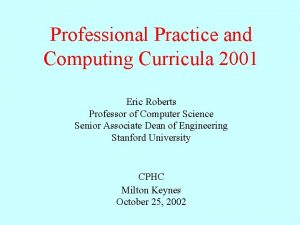Fueling the Center for Digital Curricula College of

- Slides: 1

Fueling the Center for Digital Curricula, College of Engineering, University of Michigan Manisha Vupputuri, Dominick Huynh, Edmond Tsoi, Anup Diwakar, Connor Beard, Joan Liu, Derek Chen, Siyuan Peng College of Engineering and College of LSA, University of Michigan, Ann Arbor, MI. Introduction The digital transformation of K-12 is underway – albeit painfully slowly! The resistance to change in K-12 is sincere. But, with the price of a keyboardedcomputing device now comparable to a pair of sneakers, it is clear that each and every student in each and every classroom in each and every school in the U. S. will soon have a computing device! “ 1 -to-1” is the new normal. How will the teachers and students use those computing devices? While textbooks have provided the curricula that guided teachers, the days of the printed textbook are numbered. Figure 3: Learning the letter “A” in Know. My. Letters. But, curricula is still the heartbeat of the classroom. K-12 teachers have neither the time nor the temperament nor the training to create full, year-long deeply-digital curricula. UM. CDC’s mission, then, is to provide, free, just such curricula to K-12 - curricula that teachers can then easily localize, individualize, personalize, etc. To that end, the UM. CDC has a number of projects: • Digital Curricula for Elementary School: With support from the Michigan Department of Education, UM. CDC is running a pilot study with 600+ 3 rd and 4 th graders in Michigan schools using our deeply-digital curricula. • Know. My. Letters: We are working with kindergarteners in Michigan helping them learn to print their letters. • Digital Townhall: Students need to learn how to detect fake news and fake information. We are working with students in the U. S. and Israel on developing critical thinking skills while collaborating online. • Vo. IP Supported Collaboration: Online collaboration when not co-located is increasingly becoming important. Talking while working together is important. We are adding Voice over IP to all our “collabrified” apps. With the support from faculty, staff, and K-12 educators, it is University of Michigan undergrads that are fueling the above efforts. Figure 4: A Roadmap comparing organisms today to those from the Jurassic Period. Classroom Examples Figure 5: With Roadmaps, students can work collaboratively and independently at their own pace. Concluding Remarks Figure 1: A kindergartener using Know. My. Letters to practice writing the letter “A”. The digital transformation of K-12 is underway! And the UM. CDC is doing its part to make the digital transformation of K-12 a successful transformation. Fueling the UM. CDC’s efforts are University of Michigan undergrads! Acknowledgement This work would not be possible without the support from the College of Engineering, University of Michigan. Especially, Dr. Elliot Soloway, Department of EECS, University of Michigan and Dr. Cathie Norris, Department of Learning Technologies, University of North Texas, who are co-directors of the Center for Digital Curricula. Also, we gratefully acknowledge the support of the Michigan Department of Education. The development of the Collabrify Roadmap Platform was supported, in part, with funds from George Lucas Education Research to Dr. Joseph Krajcik, director, Create For STEM Institute, MSU, with a subcontract to Dr. Annemarie Palincsar, School of Education, University of Michigan. Figure 2: Two third graders collaborating through Roadmaps. [ SURE ### ]

